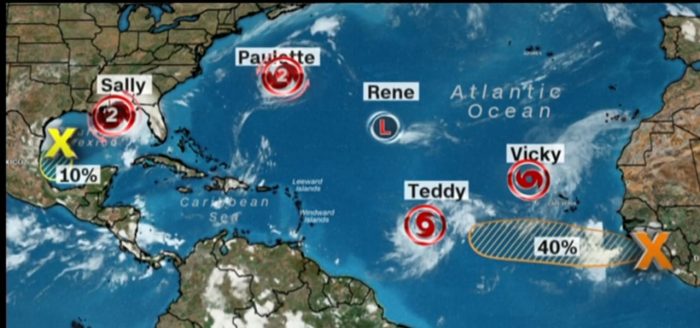This is the second time in history.
MERIDA Yucatan (NOAA/NHC) – We are at the peak of the 2020 hurricane season. And this becomes clear when you look at the Atlantic Ocean, which has five active tropical cyclones at the same time. This is the second time in history that this has happened.
The only time, before 2020, that there were five active tropical cyclones – hurricanes, tropical storms, and/or tropical depressions in the Atlantic was in 1971.
Only one name remains on the list of Atlantic hurricanes 2020.
For the 2nd time on record, the Atlantic has 5+ tropical cyclones (tropical depression (TD) or stronger) simultaneously: #Hurricane #Paulette, TD #Rene, Tropical Storm #Sally, Tropical Storm #Teddy and TD21. Other time was from September 11-14, 1971. pic.twitter.com/9ET1OoxE6f
— Philip Klotzbach (@philklotzbach) September 14, 2020
Wilfred the last name in the Atlantic.
The five systems are Hurricane Paulette, Hurricane Sally, Tropical Storm Teddy, Tropical Storm Vicky, and Tropical Depression Renee.
Hurricane Paulette made landfall early Monday morning in Bermuda. Although the system is moving away from the island, the hurricane conditions are still affecting this territory. Strong winds, storm surge, and heavy rains are likely to continue throughout the afternoon. “The swells produced by Paulette affect parts of the Leeward Islands, the Greater Antilles, the Bahamas, and the United States,” said the National Hurricane Center (NHC). “These swells could cause life-threatening waves and undertow conditions.
Hurricane Sally is headed for Louisiana, which continues to recover weeks after Hurricane Laura. Paulette is also expected to continue to strengthen as it moves into the open Atlantic. This Wednesday, the system could reach major hurricane status, with winds of at least 178 km/hr. If that happens, it would be the second hurricane to achieve this category so far in the 2020 season.
Typically, the Atlantic hurricane season averages three significant hurricanes in total. Tropical Depression Rene, a tropical storm last weekend, will continue to weaken as it moves through the central Atlantic Ocean. The storm is not expected to affect any territory and is also expected to dissipate in the next two days.
Three storms with very different impacts
Hurricane Sally is currently heading northwest across the Gulf of Mexico. Mandatory evacuations are already underway for low-lying areas along the Gulf Coast. Sally is expected to make landfall this Tuesday or Wednesday somewhere near the Louisiana-Mississippi state border. The average NHC tracking error (48 hours) is approximately 80 miles, so it is too early to determine precisely where Sally’s center will hit directly.
The NHC warns that people along the coast should not focus on the specific details of the route but the storm’s overall impact.
The significant conclusion from Hurricane Sally is a dangerous amount of water. The NHC warns that “life-threatening storms and flash floods” can occur. The highest hurricane surge is expected to be just east of where Sally makes landfall.
At this time, the NHC is forecasting a 2-3.3 meter storm surge from the Mississippi River’s mouth eastward to Ocean Springs, Mississippi, including Lake Borgne. Rising swell waters are expected to occur as far west as Burns Point, Louisiana, and as far east as St. Andrews Bay, Florida.
In addition to the storm surge, extreme amounts of rain are also anticipated in some locations.
Widespread rainfall totals along the Gulf Coast from Louisiana to the Florida peninsula are predicted to be between six and eight inches. However, some cities may record as much as two feet of rain. That amount of rain can lead to life-threatening flash flooding, including major urban and river flooding.
Tropical Storm Teddy is currently in the central Atlantic, more than 1,000 miles east of the Lesser Antilles. Teddy is expected to become a hurricane in the next few days. If this happens, Teddy will be the eighth hurricane of the 2020 Atlantic hurricane season, behind Sally. Sally became a hurricane on Monday, according to an NHC tweet.
By the end of the week, Teddy is expected to be a major hurricane (category three or higher) as it approaches Bermuda. It’s too early to say it will hit the island directly, but given the current trajectory, it will be something to follow in the next few days.
We explain the difference between climate weather storms and hurricanes
Tropical Storm Vicky is currently in the eastern Atlantic, just a few hundred miles west of the Cape Verde Islands. Vicky is the earliest named storm in the Atlantic, breaking the previous record set by Tammy on October 5, 2005.



